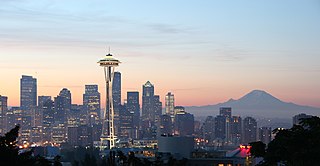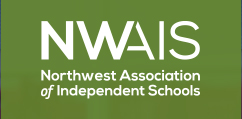Related Research Articles

Idaho is a state in the Pacific Northwest region of the United States. It borders the state of Montana to the east and northeast, Wyoming to the east, Nevada and Utah to the south, and Washington and Oregon to the west. To the north, it shares a small portion of the Canadian border with the province of British Columbia. With a population of approximately 1.7 million and an area of 83,570 square miles (216,400 km2), Idaho is the 14th largest, the 12th least populous and the 7th least densely populated of the 50 U.S. states. The state's capital and largest city is Boise.

The Cascade Range or Cascades is a major mountain range of western North America, extending from southern British Columbia through Washington and Oregon to Northern California. It includes both non-volcanic mountains, such as the North Cascades, and the notable volcanoes known as the High Cascades. The small part of the range in British Columbia is referred to as the Canadian Cascades or, locally, as the Cascade Mountains. The latter term is also sometimes used by Washington residents to refer to the Washington section of the Cascades in addition to North Cascades, the more usual U.S. term, as in North Cascades National Park. The highest peak in the range is Mount Rainier in Washington at 14,411 feet (4,392 m).

The Pacific Northwest (PNW), sometimes referred to as Cascadia, is a geographic region in western North America bounded by the Pacific Ocean to the west and, loosely, by the Rocky Mountains to the east. Though no official boundary exists, the most common conception includes the Canadian province of British Columbia (BC) and the U.S. states of Idaho, Oregon, and Washington. Broader conceptions reach north into Southeast Alaska and Yukon, south into northern California, and east to the Continental Divide to include Western Montana and parts of Wyoming. Narrower conceptions may be limited to the coastal areas west of the Cascade and Coast mountains. The variety of definitions can be attributed to partially overlapping commonalities of the region's history, culture, geography, society, and other factors.

The Great Northern Railway was an American Class I railroad. Running from Saint Paul, Minnesota, to Seattle, Washington, it was the creation of 19th-century railroad entrepreneur James J. Hill and was developed from the Saint Paul & Pacific Railroad. The Great Northern's route was the northernmost transcontinental railroad route in the U.S.

The western United States is the region comprising the westernmost states of the United States. As American settlement in the U.S. expanded westward, the meaning of the term the West changed. Before about 1800, the crest of the Appalachian Mountains was seen as the western frontier. The frontier moved westward and eventually the lands west of the Mississippi River were considered the West.

The Frontier Conference is a college athletic conference, founded in 1935 and affiliated with the NAIA. Member institutions are located in the northwestern United States, in the states of Idaho, Montana, and Oregon.

The Inland Northwest, historically and alternatively known as the Inland Empire, is a region of the American Northwest centered on the Greater Spokane Area, that includes all of Eastern Washington and North Idaho. Northeastern Oregon and Western Montana are also sometimes considered part of the Inland Northwest, but Western Montana generally is not considered part of the Inland Empire. Under some definitions, the Inland Empire also excludes Central Washington or Idaho County, Idaho.

The northwestern United States, also known as the American Northwest or simply the Northwest, is an informal geographic region of the United States. The region consistently includes the states of Oregon, Washington, Idaho, Montana and Wyoming. Some sources include Southeast Alaska in the Northwest. The related but distinct term "Pacific Northwest" generally excludes areas from the Rockies eastward.

Lincoln is the name for several proposals to create a new state in the Northwest United States. The proposed State has been defined in multiple ways, but can generally be said to be coterminous with the region known as the Inland Northwest. The proposed state was named in honor of Abraham Lincoln, who was president during the American Civil War. His name was also proposed for the states that were eventually named North Dakota and Wyoming.

The history of Washington includes thousands of years of Native American history before Europeans arrived and began to establish territorial claims. The region was part of Oregon Territory from 1848 to 1853, after which it was separated from Oregon and established as Washington Territory following the efforts at the Monticello Convention. In 1889, Washington became the 42nd state of the United States.

The concept of Cascadian bioregionalism is closely identified with the environmental movement. In the early 1970s, the contemporary vision of bioregionalism began to be formed through collaboration between natural scientists, social and environmental activists, artists and writers, community leaders, and back-to-the-landers who worked directly with natural resources. A bioregion is defined in terms of the unique overall pattern of natural characteristics that are found in a specific place. The main features are generally obvious throughout a continuous geographic terrain and include a particular climate, local aspects of seasons, landforms, watersheds, soils, and native plants and animals. People are also counted as an integral aspect of a locale's life, as can be seen in the ecologically adaptive cultures of early inhabitants, and in the activities of present-day reinhabitants who attempt to harmonize in a sustainable way with the place where they live.

Washington, officially the State of Washington, is a state in the Pacific Northwest region of the United States. Named for George Washington, the first U.S. president, the state was made out of the western part of the Washington Territory, which was ceded by the British Empire in 1846, in accordance with the Oregon Treaty in the settlement of the Oregon boundary dispute. The state, which is bordered on the west by the Pacific Ocean, Oregon to the south, Idaho to the east, and the Canadian province of British Columbia to the north, was admitted to the Union as the 42nd state in 1889. Olympia is the state capital; the state's largest city is Seattle. Washington is often referred to as Washington state to distinguish it from the nation's capital, Washington, D.C.

The Northwest Association of Independent Schools (NWAIS) is a nonprofit membership association that provides accreditation, professional development and support services to over 110 elementary, middle, and secondary independent schools in Alaska, British Columbia, Idaho, Montana, Nevada, Oregon, Utah, Washington and Wyoming.
The Orbis Cascade Alliance is a library consortium serving academic libraries in the Northwestern United States. The consortium was formed through the 2003 merger of two previous consortia, Orbis and Cascade, which incorporated libraries in Oregon and Washington, respectively. The Alliance consists of 37 governing members, consisting of colleges and universities in Oregon and Washington, plus the University of Idaho. The Alliance serves many types of libraries in a broader area that includes Oregon, Washington, Idaho, Montana, Alaska and Hawaii.

The Pacific Northwest Corridor or the Pacific Northwest Rail Corridor (PNWRC) is one of eleven federally designated higher-speed rail corridors in the United States. The 466-mile (750 km) corridor extends from Eugene, Oregon to Vancouver, British Columbia via Portland, Oregon and Seattle, Washington in the Pacific Northwest region. It was designated a high-speed rail corridor on October 20, 1992, as the fifth of five corridors called for in the Intermodal Surface Transportation Efficiency Act of 1991 (ISTEA) although it is now called a higher-speed rail since the minimum speed for a high speed rail is designated as 125 miles per hour (201 km/h). The corridor is owned by BNSF Railway in Washington and British Columbia, and by Union Pacific Railroad (UP) in Oregon, and is used by a mix of freight and passenger trains operated by BNSF, UP, and Amtrak. If improvements to the corridor are completed as proposed in Washington State's long range plan, passenger trains operating at a maximum speed of 110 miles per hour (180 km/h) would travel between Portland and Seattle, in 2 hours and 30 minutes, and between Seattle and Vancouver in 2 hours and 37 minutes by 2023.

John Miller Drake was a Union Army officer in the 1st Oregon Cavalry and the 1st Oregon Infantry regiments during the American Civil War. He eventually reached the rank of lieutenant colonel. He led one of the first campaigns to respond to the threat Chief Paulina posed to settlers and rival Indians in central Oregon. Later he was a purchasing agent for the Oregon Railway and Navigation Company.

The West Shore was a literary magazine published in Portland, Oregon, United States from 1875 to 1891. It was founded by Leopold Samuel to promote a positive image of the Pacific Northwest and to encourage economic growth in the region. The magazine was known for publishing excellent articles by well-known authors and for its many high-quality illustrations. As a result, West Shore became one of the most successful publications in the Pacific Northwest. Its finely executed illustrations showed the scenery, architecture, and commerce of Oregon, Washington, California, Idaho, Montana, British Columbia, and Alaska. Today, West Shore illustrations provide a detailed record of the Pacific Northwest as it existed in the second half of the nineteenth century.

The 8th Reserve Officers' Training Corps Brigade is a United States Army Reserve Officers' Training Corps brigade based at Joint Base Lewis-McChord, Washington.

The following works deal with the cultural, political, economic, military, biographical and geologic history of pre-territorial Oregon, Oregon Territory and the State of Oregon.
Intercollegiate Knights (IK) was a collegiate men's honorary service group founded in 1922. These chapters were oriented toward service to their campus.
References
- ↑ "OSU to help create Northwest Digital Archives". Portland Business Journal. May 13, 2002.